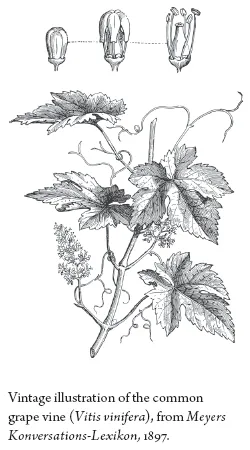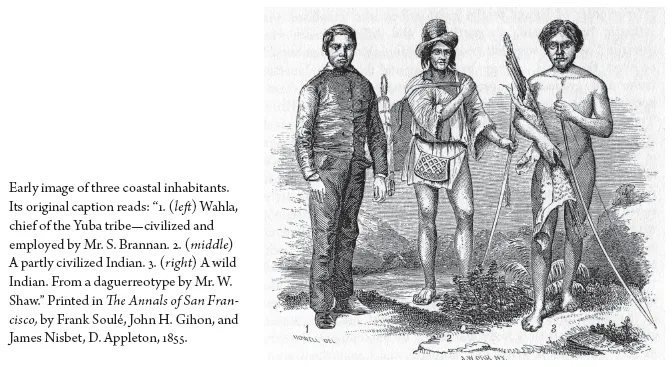![]()
PART ONE
Beginnings
Mission Vines, Vignes, and Buena Vista
The entire story of wine in California is indeed a rich pageant of continuities and associations between the Old World and the New. . . . Wine upgrades California, . . . urging it onwards to further civilization.
In wine, in the wine country, the American-as-Californian becomes, not only the pioneer coaxing virgin soil to fruition, but the heir to the ages, bent upon an immemorial task of translation and care.
—KEVIN STARR, Land’s End
![]()
CHAPTER 1
Early California, the Missions, and Their Eponymous (and Tasteless) Grape
1769–1833
The greater part of our vast country—but more especially the Pacific slope—abounds with soil and climate congenial to the culture of the grape, which is its natural home, foreign as well as native. And, therefore, all classes of wines can be made there, more particularly the potent wines, like Port, Sherry, and Madeira, in greater abundance and of as good quality as in any country.
—MATTHEW KELLER, “California Wines”
WE KNOW THAT WINE first found its way to the New World via Christopher Columbus’s ships. Historian Samuel Eliot Morison writes: “For drink they had wine, while it lasted, and water in casks, which often went bad.”1 In this context, wine was an essential beverage. As for the first vintage produced in the New World: it was also essential, but for an entirely different purpose. The Spaniards who settled Santa Elena, South Carolina, in approximately 1568 are generally thought to have been the first vintners. Their purpose was primarily sacramental: wine was used in mass. As for more established winemaking, that wouldn’t occur for another sixty-odd years, produced by Franciscan missionaries across the continent in the Southwest, in what is now New Mexico.
The first grapes of that region took root around 1626, planted along the Rio Grande at the Mission Socorro. One leading authority on the subject, Thomas Pinney, writes that the grapes the missionaries cultivated there were vinifera, the Mediterranean grape used in Europe for winemaking for thousands of years. In which case, the Spaniards and Indians of the Southwest drank wine “as it had been known in Europe since the first apparition of Dionysus.”2 Frank Schoonmaker defines vinifera thus:
Vinifera (vine-if-er-ah): By all odds the most important of the 40-odd species that make up the genus vitis. Appropriately named “the wine bearer,” Vitis vinifera, which originated in Transcaucasia in prehistoric times, is responsible for virtually all of the world’s wines (the rest are made from hybrids and from a number of native American varieties). There are more than a thousand varieties of vinifera—black, purple, blue, red, pink, amber, yellow, green—of which the most famous include Cabernet Sauvignon, Pinot Noir, Zinfandel, Nebbiolo, Chardonnay, Riesling, Sauvignon Blanc, Semillon, Chenin Blanc, and Grenache.3
Note that the grape planted in the vineyards of southwestern missions may or may not have been the grape later planted at the California missions, thusly called the Mission grape.4
And where the missionaries went, so, in time, would wine. Franciscan hands also planted the first grapes on the Pacific coast, in both Alta and Baja California. To paraphrase another authority, Vincent P. Carosso: the history of the first viticulture in California is essentially the history of the missions. Ergo, the first period of California viticulture was thus the mission period, from 1769 until 1833.5
THE DISCOVERY(IES) OF CALIFORNIA
The first colonizers could just as easily have been English, or Russian—in which case Lord knows what we’d be drinking today. But they were Spanish.
Fifty years after Columbus landed on the New World’s shores, Europeans discovered and, for reasons that are not entirely clear, named the region California. Spain, though, had acquired “legal title” to California long before any of her explorers or conquistadors even saw the place. On May 4, 1493, less than six months after Columbus discovered the Americas, Pope Alexander VI divided the so-called New World between Spain and Portugal. He assigned to Portugal all lands she might discover east of an arbitrary meridian of longitude, the Line of Demarcation (the eastern “bulge” of the future Brazil, for example), and to Spain all lands west of that line. By this decree, California—if Spain could find it—belonged to the Spanish.
In 1513, the Spaniard Vasco Núñez de Balboa reached the west coast of Panama and named the ocean he saw there the Pacific. Twenty-two years later, in 1535, another Spaniard, Hernán Cortés, discovered an “island” (in fact a peninsula) that he named California (today called Baja California). Later still, in 1542, the Spanish viceroy for New Spain, Don Antonio de Mendoza, sent Juan Rodríguez Cabrillo—a navigator (likely a Spaniard long said to have been Portuguese)6—to further explore the coastline. On September 28, 1542, in San Diego Bay, Cabrillo noted in his log: “We discovered a port closed and very good,” which he decided to call San Miguel.7 Sailing north from San Diego, they next encountered Santa Monica Bay and the Santa Barbara Channel, ultimately exploring as far north as today’s Point Reyes. But, just as others had done, Cabrillo’s ships missed the Golden Gate altogether. (This is an understandable oversight, as it’s often enshrouded in fog.)
After Cabrillo’s death in January 1543, thrashing winter winds and spoiled supplies forced his crew to return to Mexico. His voyage was the end of the first phase of Spain’s limited exploration of the California coast. Having lost their faith in the prospect, Spanish officials decided that the New World north of Mexico contained “neither wealth nor navigable passage . . . between the Atlantic and Pacific Oceans.”8 And so they ignored the region altogether, for more than two hundred years.
THE JESUITS AND THE BAJA CALIFORNIA MISSIONS: 1697–1767
A hundred and fifty years after Cabrillo’s death, in 1697, the Roman Catholic Society of Jesus—better known as the Jesuits—was granted permission to establish missions in Baja California. This sort of endeavor, of course, concerns the fervent desire to share the teachings of God with native peoples. And, as we have seen, since the Catholic mass requires sacramental wine, with missionaries comes winemaking. The first vineyard in Baja might have been planted by Father Juan de Ugarte, at Mission San Francisco Xavier, which was founded circa 1699. Later a number of the other Jesuit missions developed their own vineyards and wineries.
Accounts differ as to whether the wine produced at the missions of Baja California was ever offered for sale. In his 1789 book The History of Lower California, historian and teacher Father Don Francisco Xavier Clavigero writes: “The missionaries of [lower] California never sold their wine. . . . They used it for mass, the table, and the sick; and what was left over they sent as a gift to their benefactors or exchanged for those provisions which they received from Sinaloa and Sonora.” In addition: “There was wine at only five or six of the existing missions, and all that was made did not amount to one hundred casks, as I well know from the very ones who made it.”9 Add to this the following from Father Jacob Baegert:
Five of the missions had vineyards; and the grapes were sweet and delicious. For wine-making the berries were pressed out with the hands and the must collected in large stoneware jars brought from Manila. The wine was excellent. There was no want of cellars; but the difficulty was to find such as were cool enough; and it was not infrequent to have the wine overheated and spoiled. As, however, very little was used except for church purposes, there was enough to supply all the missions of the peninsula and a number of those on the other side of the gulf.10 (Emphasis added.)
The above text, which appeared in the first volume of Theodore H. Hittell’s 1898 History of California, was translated from a 1773 German text, Nachrichten Von Der Amerikanischen Halbinsel Californien (Account of the American Peninsula of California). That German work was later published by the University of California Press, providing more of the original text in a translation that is intriguingly different in parts:
It was not necessary to buy sacramental wine elsewhere. The land produces it, and without doubt it could become an excellent and generous product if cool cellars, good barrels, and skilled vintners were available, because the grapes are honey-sweet and of superior flavor. Five missions have vineyards. The juice is merely pressed from the grapes by hand and stored in stone jars. These jars hold approximately fifteen measures (one measure is two quarts, approximately) and are left by the ship which makes a yearly visit to California on her way from the Philippine island of Luzón to Acapulco in Mexico. The storage cellar for the wine is an ordinary room on level ground and—in California—necessarily warm. Therefore usually half of the grape juice, or even more of it, turns to vinegar. Ten or fifteen jars full of sacramental wine were sent each year to the missions across the California Sea and to the four or six missions in California which had no vineyards. When it left the cellar, the wine was good, but it did not always arrive in the same condition because it had to be carried on muleback in the hot sun for fifty or more hours. As a result, the wine often turned sour, sometimes on the way, sometimes soon after it was delivered.
It was not permissible to give wine to the Indians. Some of the missionaries never tasted any except during Mass. One measure of it sold for six florins, so that neither soldier nor sailor could afford to get drunk frequently. Yet there was no aged or choice wine in California.
From these facts it can be seen that only a small quantity of wine was successfully produced. It was not surprising that many times I and my colleagues had no wine, even for the Holy Mass. Yet it has been claimed that the missionaries of California sold much wine and sent it to other lands.11 (Emphasis added.)
In 1767, following the lead of Portugal (in 1759) and France (in 1764), a Spanish court opted to force the Jesuits from the New World—that is, from South America, from Central America, and from western North America. Exactly why the Jesuits were expelled remains a mystery to historians; one lasting theory—or, as Caughey puts it, “wild rumor”—is that the Jesuits were suspected of operating for personal gain, perhaps—again from Caughey—“hoarding vast treasures from secret mines [or] pearl fisheries,” or simply extorting from the natives.
Next began the process of transitioning oversight of the missions from the Jesuits to the Franciscans; regarding that endeavor, Father Junípero Serra was named president of all California missions. Six months later, on July 16, 1769, the Franciscan padres dedicated Mission San Diego de Alcalá, the first of a string of California missions that would begin European colonization of California, as well as...


